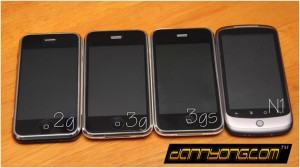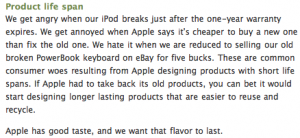An All Consuming Society
In my previous blog post I talked about becoming more aware of the mass consumer society in which the entire world is a part of after the Copenhagen accord. This happened in two ways: one, seeing the amount of brochures that were consumed at the conference and two, seeing the craze created with electronic product cycles. Since I’ve probably got Dickinson College BANNED from ever coming back to the any COP (just kidding) I’ll focus on consumer consumption in this blogpost–particularly product cycles and how the combined advertisement saturation by Madison Avenue and corporations creates unsustainable demand among consumers.
In one of our many discussions in Copenhagen, the 15 of us were in our small kitchen in the Hotel Loven talking about a variety of different things. I, the videographer for these meetings had a unique perspective on things. Sometimes I’d tape stealthy–sometimes out in the open, but usually it didn’t matter what exactly was being taped–people generally spoke their minds. One particular evening, the topic of consumer product cycles came up. Brett Cassette, as he likes to be called, spoke about televisions and how that every year a new processor or doodad will be implemented into a television set that makes the new one irrelevant. Thus, the product that the Smith family just picked up from Big Blue Box retailer only a mere 6 months ago is out of date. It still functions well–just not AS well as the newer television. This was a big issue when desktop PCs were popular. If one would go to out to buy a new computer, 18 months from that time a computer with double the processing ability comes out–this is Moore’s law in effect. It is unavoidable–and just how the industry works. This product cycle created a mass hysteria with people who were once not be considered the mainstream market. These were people who update their desktop towers on a 6 month basis when a new video card hit the market or a new processor. Over the last decade or so, this has translated onto the mainstream market–perhaps video game consoles being the first signs of this happening. Video game consoles have a six year lifecycle–advertising blitzes create mass hysteria and incite demand. Consumers line up outside of retail stores to buy them and replace the previous product in the lineup. Not too sustainable, but a six year product lifecycle is the average.

Fast forward to 2007 and we have the launch of Apple’s darling, the iPhone. The product is launched to a feverish crowd at an outrageous price of 599 dollars. The mass gobbles it up. On to 2008–Apple launches the iPhone 3G. Early iPhone adopters are angry because their product is now out of date. Forums are filled with posters trying to finagle their way out of their contract or trick Apple Support agents into giving them the new iPhone. The iPhone 3G becomes one of the fastest selling products in history. Fast forward to 2009, and the iPhone 3GS launches. Now, the iPhone 3G owners are angry as this iPhone is advertised as being the fastest and most powerful iPhone yet. With the iPhone 4’s release imminent, this vicious consumer craze is likely to happen again.
Perhaps the best question to ask is–whose fault is it? We will use Apple as an example again. Apple knows their products sell themselves. They know consumers pine for anything containing their logo and design finesse. Greenpeace created an iPoison website about Apple back in 2005. They’ve even adapted to numerous demands by Greenpeace to take some of the worst chemicals out of their products:
“Apple has declared a phase out ofthe worst chemicals in its product range, Brominated Fire Retardants(BFRs) and Polyvinyl Chloride (PVC) by 2008. Way to go Steve.”
Yes, Apple is doing everything possible to curtail their environmental footprint. What needs to happen though? One would think that the economy at its lowest would silence this kind of consumer behavior. No. High end electronics are selling just as well. Companies need to make money. Extending a product’s lifecycle means lower revenue streams.
Consumers need to silence that inherent desire in them to have “the latest and greatest.” As a technophile, it is something that I’ve suffered with for quite some time. Slowing down our buying processes will force companies to alter their production habits–perhaps from a year to a year and a half. But when people are breaking their cell phone contracts to buy new phones it sends a message to the herders that the flock is continually getting easier to be manipulated. We need to be green consumers–and not the green that Madison Avenue is talking about. They have commodified green–selling bags, shirts, water bottles and other green products. While this is surely a major improvement from prior years, the primary objective of consumers should be to curtail their own desires and that little voice inside that says “buy buy buy, must have.” Corporations will always be producing and selling new and exciting products but the responsibility has to lie in the new, sustainable consumer to get over appearing outdated in lieu of being glitzy. Being sustainable has to become the new sexy.
Tags: Apple, consumerism, Green
